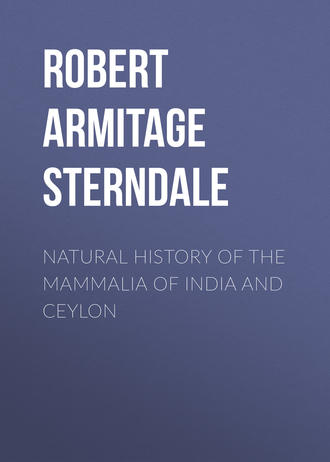 полная версия
полная версияNatural History of the Mammalia of India and Ceylon
NATIVE NAME.—Ellee Wanderu (Kellaart).
HABITAT.—Ceylon.
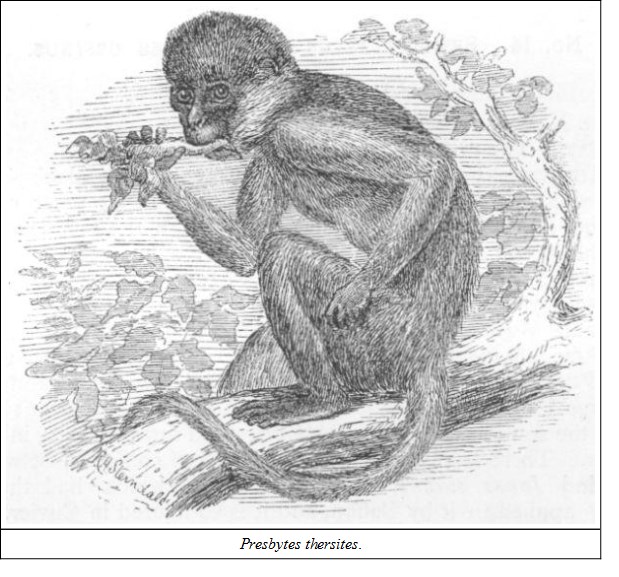
DESCRIPTION.—Chiefly distinguished from the others by wanting the head tuft; uniform dusky grey, darker on crown and fore-limbs; slaty brown on wrists and hands; hair on toes whitish; whiskers and beard largely developed and conspicuously white.
The name was given by Blyth to a single specimen forwarded by Dr. Templeton, and it was for a time doubtful whether it was really a native, till Dr. Kellaart procured a second. Dr. Templeton's specimen was partial to fresh vegetables, plantains, and fruit, but he ate freely boiled rice, beans, and gram. He was fond of being noticed and petted, stretching out his limbs in succession to be scratched, drawing himself up so that his ribs might be reached by the finger, closing his eyes during the operation, and evincing his satisfaction by grimaces irresistibly ludicrous.—Emerson Tennent.
Dr. Anderson considers this monkey as identical with Semnopithecus priamus, but Kellaart, as I have before stated, is very positive on the point of difference, calling S. priamus emphatically the crested monkey, and alleging that thersites has no crest, and it is probable he had opportunities of observing the two animals in life; he says he had a young specimen of priamus, which distinctly showed the crest, and a young thersites of the same age which showed no sign of it.
In Emerson Tennent's 'Natural History of Ceylon,' (1861) page 5, there is a plate of a group in which are included priamus and thersites; in the original they are wrongly numbered—the former should be 2 and not 3, and the latter 3 and not 2. If these be correct (and Wolf's name should be a voucher for their being so) there is a decided difference. There is no crest in the latter, and the white whiskers terminate abruptly on a level with the eyebrow, and the superciliary ridge of hair is wanting.
NO. 16. SEMNOPITHECUS vel PRESBYTES ALBINUS (Kellaart)The White LangurHABITAT.—Ceylon, in the hills beyond Matelle.
DESCRIPTION.—Fur dense, sinuous, nearly of uniform white colour, with only a slight dash of grey on the head; face and ears black; palm, soles, fingers and toes flesh-coloured; limbs and body the shape of P. ursinus; long white hairs prolonged over the toes and claws, giving the appearance of a white spaniel dog to this monkey; irides brown; whiskers white, full, and pointed laterally.—Kellaart.
The above description was taken by Dr. Kellaart from a living specimen. He considered it to be a distinct species, and not an Albino, from the black face and ears and brown eyes.
The Kandyans assured him that they were to be seen (rarely however) in small parties of three and four over the hills beyond Matelle, but never in company with the dark kind.
Emerson Tennent also mentions one that was brought to him taken between Ambepasse and Kornegalle, where they were said to be numerous; except in colour it had all the characteristics of P. cephalopterus. So striking was its whiteness that it might have been conjectured to be an Albino, but for the circumstance that its eyes and face were black. An old writer of the seventeenth century, Knox, says of the monkeys of Ceylon (where he was captive for some time) that there are some "milk-white in body and face, but of this sort there is not such plenty."—Tennent's 'Natural History of Ceylon,' page 8.
NOTE.—Since the above was in type I have found in the List of Animals in the Zoological Society's Gardens, a species entered as Semnopithecus leucoprymnus, the Purple-faced Monkey from Ceylon—see P.Z.S.
PAPIONINÆThis sub-family comprises the true baboons of Africa and the monkey-like baboons of India. They have the stomach simple, and cheek-pouches are always present. According to Cuvier they possess, like the last family, a fifth tubercle on their last molars. They produce early, but are not completely adult for four or five years; the period of gestation is seven months.
The third sub-family of Simiadæ consists of the genera Cercopithicus, Macacus, and Cynocephalus, as generally accepted by modern zoologists, but Jerdon seems to have followed Ogilby in his classification, which merges the long-tailed Macaques into Cercopithecus, and substituting Papio for the others.
GENUS INUUSCuvier applies this term to the Magots or rudimentary-tailed Macaques. The monkeys of this genus are more compactly built than those of the last. They are also less herbivorous in their diet, eating frogs, lizards, crabs and insects, as well as vegetables and fruit. Their callosities and cheek-pouches are large, and they have a sac which communicates with the larynx under the thyroid cartilage, which fills with air when they cry out.
Some naturalists of the day, however, place all under the generic name Macacus.
NO. 17. INUUS vel MACACUS SILENUSThe Lion Monkey (Jerdon's No. 6)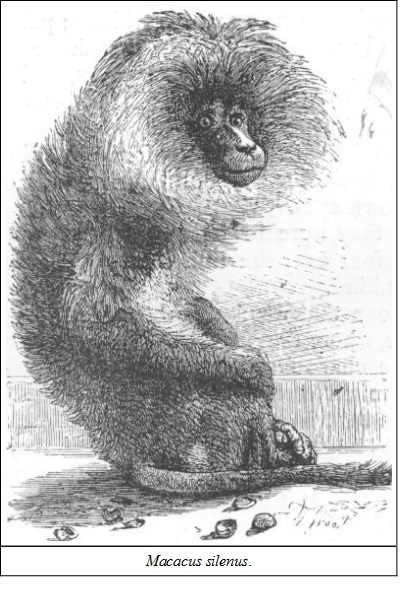
NATIVE NAMES.—Nil bandar, Bengali; Shia bandar, Hindi; Nella manthi, Malabari.
HABITAT.—The Western Ghâts of India from North Lat. 14° to the extreme south, but most abundant in Cochin and Travancore (Jerdon), also Ceylon (Cuvier and Horsfield), though not confirmed by Emerson Tennent, who states that the silenus is not found in the island except as introduced by Arab horse-dealers occasionally, and that it certainly is not indigenous. Blyth was also assured by Dr. Templeton of Colombo that the only specimens there were imported.
DESCRIPTION.—Black, with a reddish-white hood or beard surrounding the face and neck; tail with a tuft of whitish hair at the tip; a little greyish on the chest.
SIZE.—About 24 inches; tail, 10 inches.
There is a plate of this monkey in Carpenter and Westwood's edition of Cuvier, under the mistaken name of Wanderoo.
It is somewhat sulky and savage, and is difficult to get near in a wild state. Jerdon states that he met with it only in dense unfrequented forest, and sometimes at a considerable elevation. It occurs in troops of from twelve to twenty.
NO. 18. INUUS vel MACACUS RHESUSThe Bengal Monkey (Jerdon's No. 7)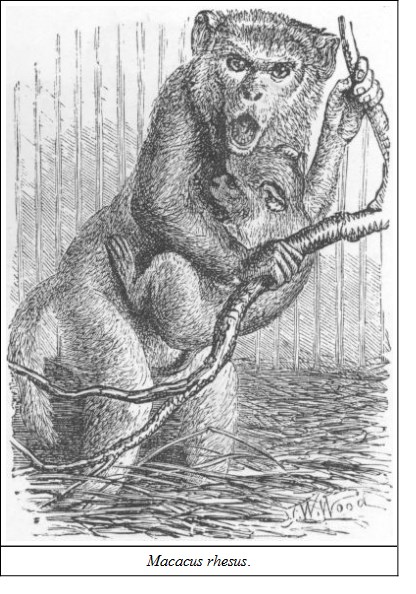
NATIVE NAMES.—Bandar, Hindi; Markot, Bengali; Suhu, Lepcha, Piyu, Bhotia.
HABITAT.—India generally from the North to about Lat. 18° or 19°; but not in the South, where it is replaced by Macacus radiatus.
DESCRIPTION.—Above brownish ochrey or rufous; limbs and beneath ashy-brown; callosities and adjacent parts red; face of adult males red.
SIZE.—Twenty-two inches; tail 11 inches.
This monkey is too well-known to need description. It is the common acting monkey of the bandar-wallas, the delight of all Anglo-Indian children, who go into raptures over the romance of Munsur-ram and Chameli, their quarrels, parting, and reconciliation, so admirably acted by these miniature comedians.
NOTE.—For Macacus rheso-similis, Sclater, see P.Z.S. 1872, p. 495, pl. xxv., also P.Z.S. 1875, p. 418.
NO. 19. INUUS vel MACACUS PELOPS Syn.—MACACUS ASSAMENSISThe Hill Monkey (Jerdon's No. 8)HABITAT.—The Himalayan ranges and Assam.
DESCRIPTION.—Brownish grey, somewhat mixed with slaty, and rusty brownish on the shoulders in some; beneath light ashy brown; fur fuller and more wavy than in rhesus; canine teeth long; of stout habit; callosities and face less red than in the last species (Jerdon). Face flesh-coloured, but interspersed with a few black hairs (McClelland).
NO. 20. INUUS vel MACACUS NEMESTRINUSThe Pig-tailed MonkeyHABITAT.—Tenasserim and the Malay Archipelago.
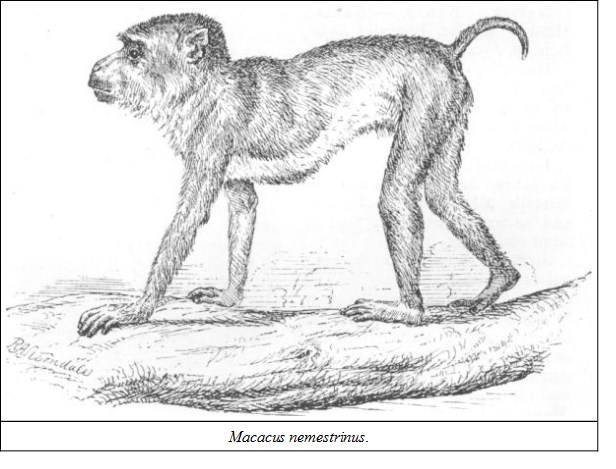
DESCRIPTION.—General colour grizzled brown; the piles annulated with dusky and fulvous; crown darker, and the middle of the back also darker; the hair lengthened on the fore-quarters; the back stripe extends along the tail, becoming almost black; the tail terminates in a bright ferruginous tuft. This monkey is noted for its docility, and in Bencoolen is trained to be useful as well as amusing. According to Sir Stamford Raffles it is taught to climb the cocoa palms for the fruit for its master, and to select only those that are ripe.
NO. 21. INUUS vel MACACUS LEONINUSThe Long-haired Pig-tailed MonkeyHABITAT.—Arracan.
DESCRIPTION.—A thick-set powerful animal, with a broad, rather flattened head above, and a moderately short, well clad, up-turned tail, about one-third the length of the body and head; the female smaller.—Anderson.
Face fleshy brown; whitish round the eyes and on the forehead; eyebrows brownish, a narrow reddish line running out from the external angle of the eye. The upper surface of the head is densely covered with short dark fur, yellowish brown, broadly tipped with black; the hair radiating from the vertex; on and around the ear the hair is pale grey; above the external orbital angle and on the sides of the face the hair is dense and directed backwards, pale greyish, obscurely annulated with dusky brown, and this is prolonged downwards to the middle of the throat. On the shoulders, back of the neck, and upper part of the thighs, the hairs are very long, fully three inches in the first-mentioned localities; the basal halves greyish; and the remainder ringed with eleven bands of dark brown and orange; the tips being dark. The middle and small of the back is almost black, the shorter hair there being wholly dark; and this colour is prolonged on the tail, which is tufted. The hair on the chest is annulated, but paler than on the shoulders, and it is especially dense on the lower part. The lower halves of the limbs are also well clad with annulated fur, like their outsides, but their upper halves internally and the belly are only sparsely covered with long brownish grey plain hairs, not ringed.
The female differs from the male in the absence of the black on the head and back, and in the hair of the under parts being brownish grey, without annulations. The shoulders somewhat brighter than the rest of the fur, which is yellowish olive; greyish olive on outside of limbs; dusky on upper surface of hands and feet; and black on upper surface of tail.
SIZE.—Length of male, head and body 23 inches; tail, without hair, 8 inches; with hair 10 inches.
The above description is taken from Dr. Anderson's account, 'Anat. and Zool. Res.,' where at page 54 will be found a plate of the skull showing the powerful canine teeth. Blyth mentions a fine male with hair on the shoulders four to five inches long.
NO. 22. INUUS vel MACACUS ARCTOIDESThe Brown Stump-tailed MonkeyHABITAT.—Cachar, Kakhyen Hills, east of Bhamo.
DESCRIPTION.—Upper surface of head and along the back dark brown, almost blackish; sides and limbs dark brown; the hair, which is very long, is ringed with light yellowish and dark brown, darker still at the tips; face red; tail short and stumpy, little over an inch long.
This monkey is one over which many naturalists have argued; it is synonymous with Macacus speciosus, M. maurus, M. melanotus, and was thought to be with M. brunneus till Dr. Anderson placed the latter in a separate species on account of the non-annulation of its hair. It is essentially a denizen of the hills; it has been obtained in Cachar and in Upper Assam. Dr. Anderson got it in the Kakhyen Hills on the frontier of Yunnan, beyond which, he says, it spreads to the southeast to Cochin-China.
NO. 23. INUUS vel MACACUS THIBETANUSThe Thibetan Stump-tailed MonkeyDESCRIPTION.—Head large and whiskered; form robust; tail stumpy and clad; general colour of the animal brown; whiskers greyish; face nude and flesh-coloured, with a deep crimson flush round the eyes.
SIZE.—Two feet 9 inches; tail about 3 inches.
This large monkey, though not belonging to British India, inhabiting, it is said, "the coldest and least accessible forests of Eastern Thibet," is mentioned here, as the exploration of that country by travellers from India is attracting attention.
GENUS MACACUSTail longer than in Inuus, and face not so lengthened; otherwise as in that genus.—Jerdon.
NO. 24. MACACUS RADIATUSThe Madras Monkey (Jerdon's No. 9)NATIVE NAMES.—Bandar, Hindi; Makadu or Wanur, Mahratti; Kerda mahr of the Ghâts; Munga, Canarese; Koti, Telegu; Vella munthi, Malabar.
HABITAT.—All over the southern parts of India, as far north as lat. 18°.
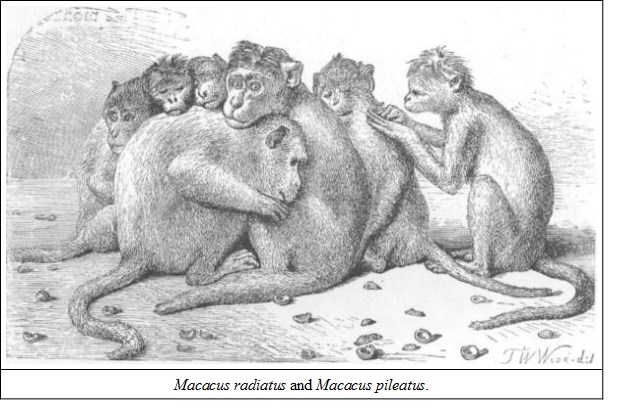
DESCRIPTION.—Of a dusky olive brown, paler and whitish underneath, ashy on outer sides of limbs; tail dusky brown above, whitish beneath; hairs on the crown of the head radiated.
SIZE.—Twenty inches; tail 15 inches.
Elliott remarks of this monkey that it inhabits not only the wildest jungles, but the most populous towns, and it is noted for its audacity in stealing fruit and grain from shops. Jerdon says: "It is the monkey most commonly found in menageries, and led about to show various tricks and feats of agility. It is certainly the most inquisitive and mischievous of its tribe, and its powers of mimicry are surpassed by none." It may be taught to turn a wheel regularly; it smokes tobacco without inconvenience.—Horsfield.
NO. 25. MACACUS PILEATUS (vel SINICUS, Lin.) The Capped Monkey, or Bonneted Macaque of CuvierNATIVE NAME.—Rilawa, Singhalese.
HABITAT.—Ceylon and China.
DESCRIPTION.—Yellowish brown, with a slight shade of green in old specimens; in some the back is light chestnut brown; yellowish brown hairs on the crown of the head, radiating from the centre to the circumference; face flesh-coloured and beardless; ears, palms, soles, fingers, and toes blackish; irides reddish brown; callosities flesh-coloured; tail longish, terminating in short tuft.—Kellaart.
SIZE.—Head and body about 20 inches; tail 18 inches.
This is the Macacus sinicus of Cuvier, and is very similar to the last species. In Ceylon it takes the place of our rhesus monkey with the conjurors, who, according to Sir Emerson Tennent, "teach it to dance, and in their wanderings carry it from village to village, clad in a grotesque dress, to exhibit its lively performances." It also, like the last, smokes tobacco; and one that belonged to the captain of a tug steamer, in which I once went down from Calcutta to the Sandheads, not only smoked, but chewed tobacco. Kellaart says of it: "This monkey is a lively, spirited animal, but easily tamed; particularly fond of making grimaces, with which it invariably welcomes its master and friends. It is truly astonishing to see the large quantity of food it will cram down its cheek pouches for future mastication."
NO. 26. MACACUS CYNOMOLGUSThe Crab-eating MacaqueNATIVE NAME.—Kra, Malay.
HABITAT.—Tenasserim, Nicobars, Malay Archipelago.
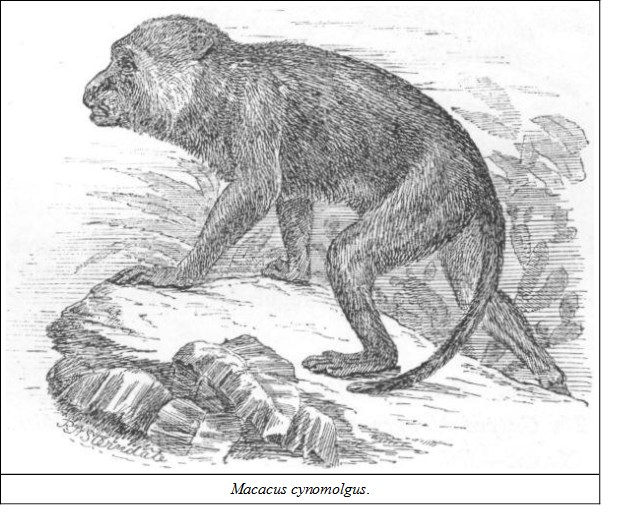
DESCRIPTION.—"The leading features of this animal are its massive form, its large head closely set on the shoulders, its stout and rather short legs, its slender loins and heavy buttocks, its tail thick at the base" (Anderson). The general colour is similar to that of the Bengal rhesus monkey, but the skin of the chest and belly is bluish, the face livid, with a white area between the eyes and white eyelids. Hands and feet blackish.
SIZE.—About that of the Bengal rhesus.
According to Captain (now Sir Arthur) Phayre "these monkeys frequent the banks of salt-water creeks and devour shell-fish. In the cheek-pouch of the female were found the claws and body of a crab. There is not much on record concerning the habits of this monkey in its wild state beyond what is stated concerning its partiality for crabs, which can also, I believe, be said of the rhesus in the Bengal Sunderbunds."
NO. 27. MACACUS CARBONARIUSThe Black-faced Crab-eating MonkeyHABITAT.—Burmah.
DESCRIPTION.—In all respects the same as the last, except that its face is blackish, with conspicuously white eyelids.
FAMILY LEMURIDÆThe Indian members of this family belong to the sub-family named by Geoffroy Nycticebinæ.
GENUS NYCTICEBUSNO. 28. NYCTICEBUS TARDIGRADUSThe Slow-paced Lemur (Jerdon's No. 10)NATIVE NAME.—Sharmindi billi, Hindi.
HABITAT.—Eastern Bengal, Assam, Garo Hills, Sylhet, Arracan.—Horsfield.
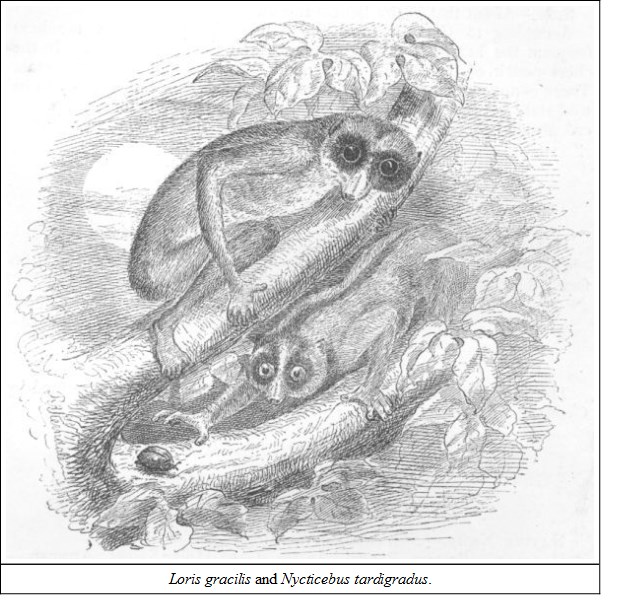
DESCRIPTION.—Dark ashy grey, with a darker band down middle of back, beneath lighter grey; forehead in some dark, with a narrow white stripe between the eyes, disappearing above them; ears and round the eye dark; tail very short.—Jerdon.
SIZE.—Length about 14 to 15 inches; tail 5/8 of an inch.
Nocturnal in its habits; sleeping during the day in holes of trees, and coming out to feed at night. Sir William Jones describes one kept by him for some time; it appeared to have been gentle, though at times petulant when disturbed; susceptible of cold; slept from sunrise to sunset rolled up like a hedgehog. Its food was chiefly plantains, and mangoes when in season. Peaches, mulberries, and guavas, it did not so much care for, but it was most eager after grasshoppers, which it devoured voraciously. It was very particular in the performance of its toilet, cleaning and licking its fur. Cuvier also notices this last peculiarity, and with regard to its diet says it eats small birds as well as insects. These animals are occasionally to be bought in the Calcutta market. A friend of mine had a pair which were a source of great amusement to his guests after dinner. (See Appendix C.)
GENUS LORISBody and limbs slender; no tail; eyes very large, almost contiguous; nose acute.
NO. 29. LORIS GRACILISThe Slender Lemur (Jerdon's No. 11)NATIVE NAMES.—Tevangar, Tamil; Dewantsipilli, Telegu. (Oona happslava, Singhalese.—Kellaart.)
HABITAT.—Southern India and Ceylon.
DESCRIPTION.—Above greyish rufescent (tawny snuff brown: Kellaart); beneath a paler shade; a white triangular spot on forehead, extending down the nose; fur short, dense, and soft; ears thin, rounded (Jerdon). A hooped claw on inner toes; nails of other toes flat; posterior third of palms and soles hairy (Kellaart).
SIZE.—About 8 inches; arm, 5; leg, 5½.
This, like the last, is also nocturnal in its habits, and from the extreme slowness of its movements is called in Ceylon "the Ceylon sloth." Its diet is varied—fruit, flower, and leaf buds, insects, eggs, and young birds. Sir Emerson Tennent says the Singhalese assert that it has been known to strangle pea-fowl at night and feast on the brain, but this I doubt. Smaller birds it might overcome. Jerdon states that in confinement it will eat boiled rice, plantains, honey or syrup and raw meat. McMaster, at page 6 of his 'Notes on Jerdon,' gives an interesting extract from an old account of 'Dr. John Fryer's Voyage to East India and Bombain,' in which he describes this little animal as "Men of the Woods, or more truly Satyrs;" asleep during the day; but at "Night they Sport and Eat." "They had Heads like an owl. Bodied like a monkey without Tails. Only the first finger of the Right Hand was armed with a claw like a bird, otherwise they had hands and feet which they walk upright on, not pronely, as other Beasts do."
These little creatures double themselves up when they sleep, bending the head down between their legs. Although so sluggish generally, Jerdon says they can move with considerable agility when they choose.
SUB-ORDER PLEUROPTERA.—FAMILY GALÆOPITHECIDÆThere is a curious link between the Lemurs and the Bats in the Colugos. (Galæopithecus): their limbs are connected with a membrane as in the Flying Squirrels, by which they can leap and float for a hundred yards on an inclined plane. They are mild, inoffensive animals, subsisting on fruits and leaves. Cuvier places them after the Bats, but they seem properly to link the Lemurs and the frugivorous Bats. As yet they have not been found in India proper, but are common in the Malayan Peninsula, and have been found in Burmah.
GENUS GALÆOPITHECUSNO. 30. GALÆOPITHECUS VOLANSThe Flying LemurNATIVE NAME.—Myook-hloung-pyan, Burmese.
HABITAT.—Mergui; the Malayan Peninsula.
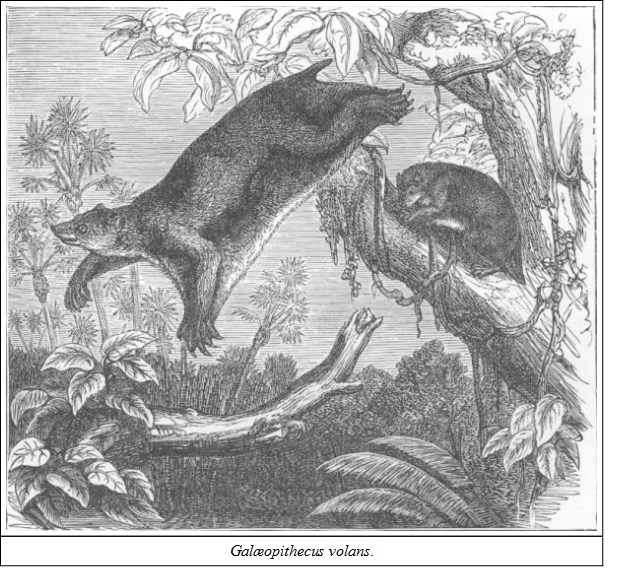
DESCRIPTION.—Fur olive brown, mottled with irregular whitish spots and blotches; the pile is short, but exquisitely soft; head and brain very small; tail long and prehensile. The membrane is continued from each side of the neck to the fore feet; thence to the hind feet, again to the tip of the tail. This animal is also nocturnal in its habits, and very sluggish in its motions by day, at which time it usually hangs from a branch suspended by its fore hands, its mottled back assimilating closely with the rugged bark of the tree; it is exclusively herbivorous, possessing a very voluminous stomach, and long convoluted intestines. Wallace says of it, that its brain is very small, and it possesses such tenacity of life that it is very difficult to kill; he adds that it is said to have only one at a birth, and one he shot had a very small blind naked little creature clinging closely to its breast, which was quite bare and much wrinkled. Raffles, however, gives two as the number produced at each birth. Dr. Cantor says that in confinement plantains constitute the favourite food, but deprived of liberty it soon dies. In its wild state it "lives entirely on young fruits and leaves; those of the cocoanut and Bombax pentandrum are its favourite food, and it commits great injury to the plantations of these."—Horsfield's 'Cat. Mam.' Regarding its powers of flight, Wallace, in his 'Travels in the Malay Archipelago,' says: "I saw one of these animals run up a tree in a rather open space, and then glide obliquely through the air to another tree on which it alighted near its base, and immediately began to ascend. I paced the distance from one tree to the other, and found it to be seventy yards, and the amount of descent not more than thirty-five or forty feet, or less than one in five. This, I think, proves that the animal must have some power of guiding itself through the air, otherwise in so long a distance it would have little chance of alighting exactly upon the trunk."
There is a carefully prepared skeleton of this animal in the Indian Museum in Calcutta.
ORDER CARNARIA
CHEIROPTERAIt may seem strange to many that such an insignificant, weird little creature as a bat should rank so high in the animal kingdom as to be but a few removes from man. It has, however, some striking anatomical affinities with the last Order, Quadrumana, sufficient to justify its being placed in the next link of the great chain of creation.
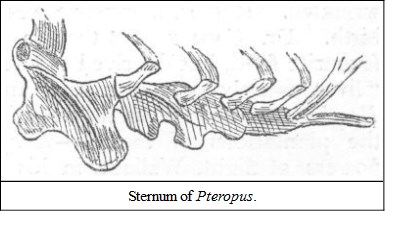
"Bats have the arms, fore-arms and fingers excessively elongated, so as to form with the membrane that occupies their intervals, real wings, the surface of which is equally or more extended than in those of birds. Hence they fly high and with great rapidity."—Cuvier. They suckle their young at the breast, but some of them have pubic warts resembling mammæ. The muscles of the chest are developed in proportion, and the sternum has a medial ridge something like that of a bird. They are all nocturnal, with small eyes (except in the case of the frugivorous bats), large ears, and in some cases membranous appendages to the nostrils, which may possibly be for the purpose of guiding themselves in the dark, for it is proved by experiment that bats are not dependent on eyesight for guidance, and one naturalist has remarked that, in a certain species of bat which has no facial membrane, this delicacy of perception was absent. I have noticed this in one species, Cynopterus marginatus, one of which flew into my room not long ago, and which repeatedly dashed itself against a glass door in its efforts to escape. I had all the other doors closed.



